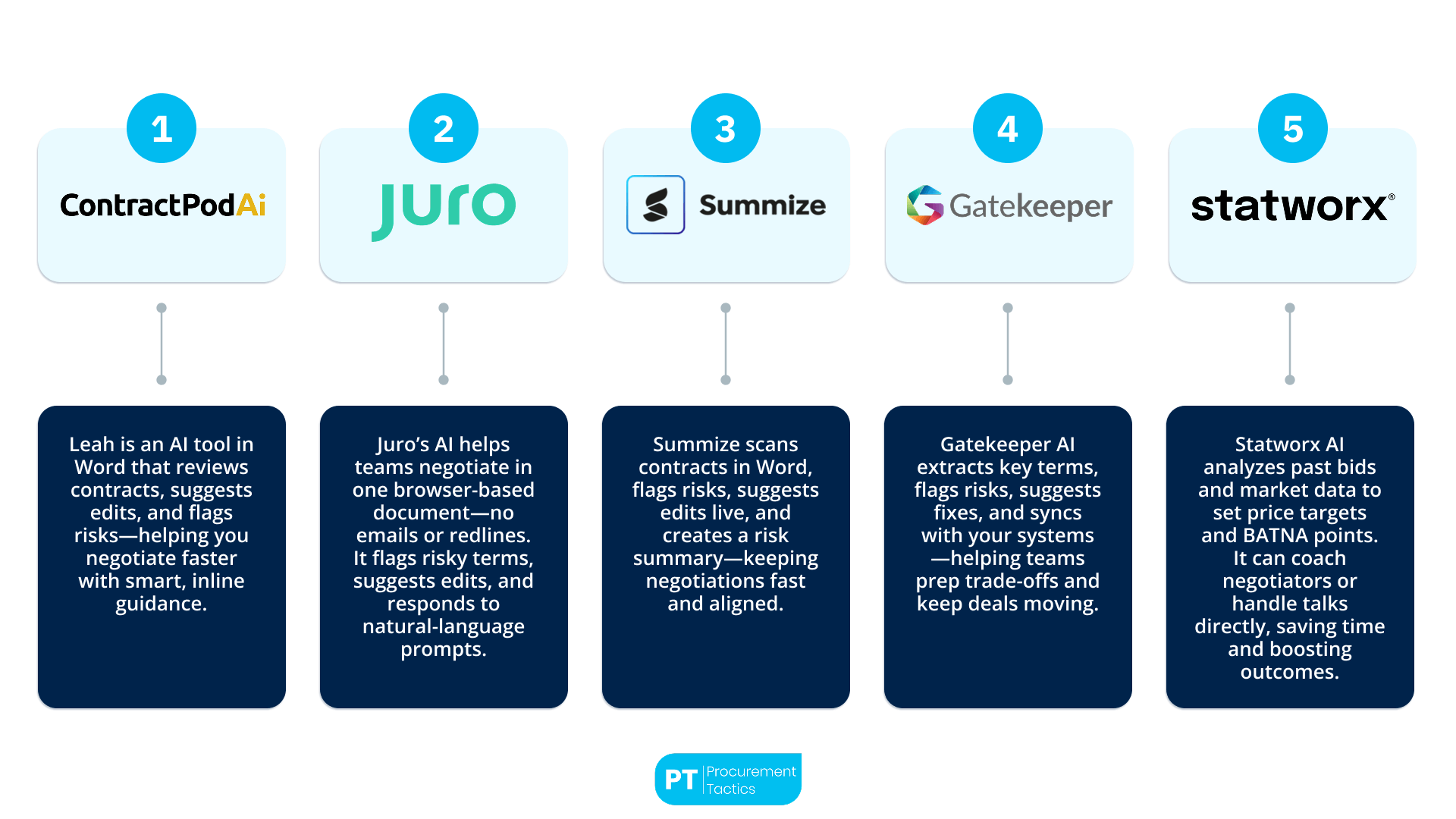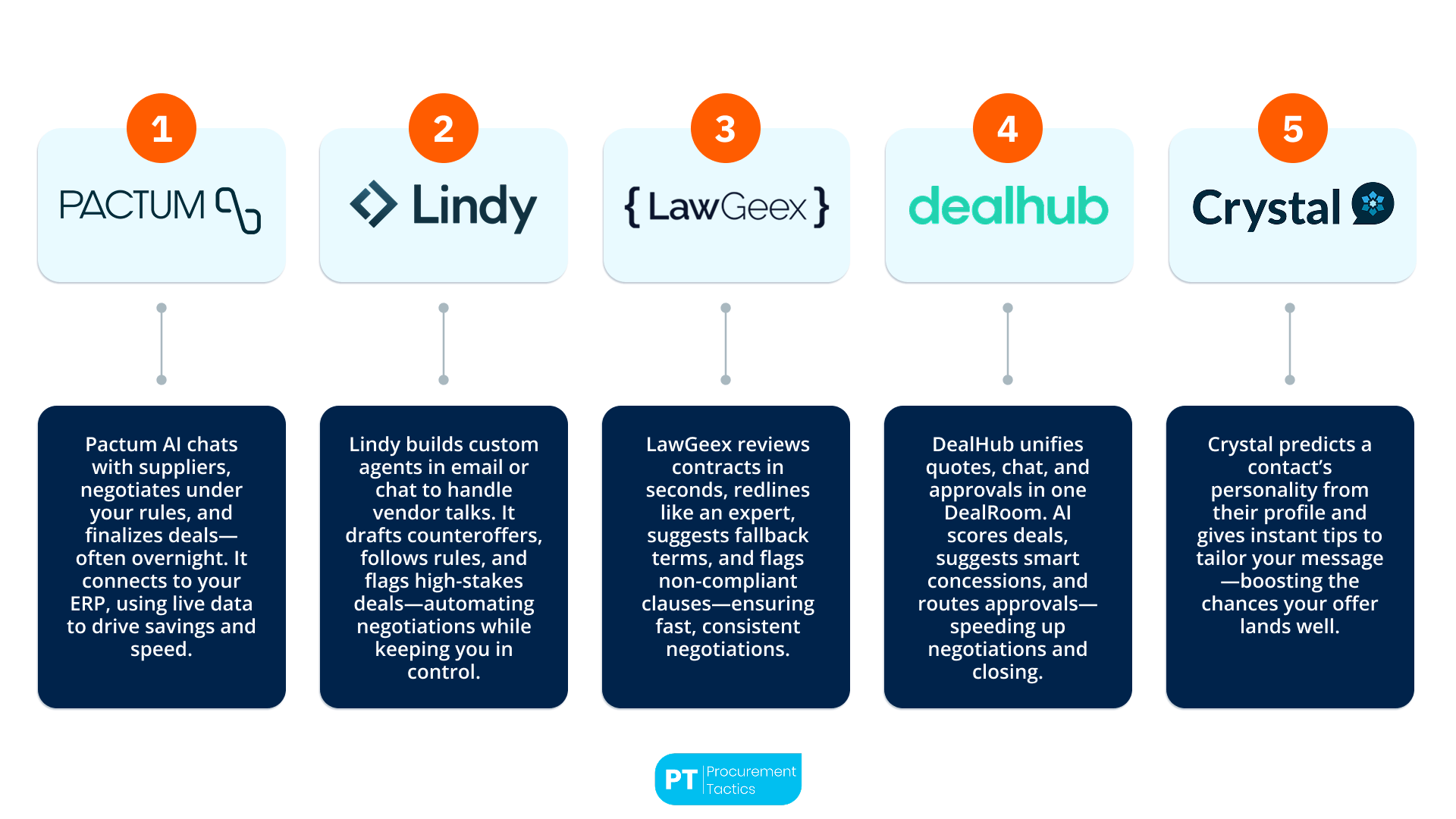Written by Marijn Overvest | Reviewed by Sjoerd Goedhart | Fact Checked by Ruud Emonds | Our editorial policy
5 Best AI Tools for Negotiations + Examples

As taught in the Negotiation Course for Procurement Professionals Course / ★★★★★ 4.9 rating
- AI tools for negotiations are software platforms that leverage machine learning to analyze contract clauses, flag risks, and propose optimized fallback language.
- AI tools for negotiations automate the benchmarking of terms against historical deals and internal playbooks to guide data-driven bargaining decisions.
- AI tools for negotiations deliver real-time insights, conversational redlining, and analytics dashboards to accelerate deal cycles and enhance negotiation outcomes.
What are AI Tools for Negotiations?
AI negotiation tools are software platforms that use natural language processing, big language models, and optimization algorithms to augment or even automate tasks typically performed by human negotiators.
In the preparation phase, contract lifecycle management packages, AI tools input draft agreements, highlight risky clauses, and recommend red lines in seconds, while predictive analytics modules examine historical bid requests or market data to set target price ranges and breakpoints.
Once negotiations begin, AI tools move from analysis to real-time execution. Autonomous agents can be given hedges (target discount, payment terms, delivery deadlines) and then allowed to negotiate with hundreds of suppliers simultaneously.
The result of implementing AI negotiation tools is shorter cycles, consistent implementation of corporate plans, and measurable savings, provided that organizations verify data security controls and reconcile AI results with human signatures before anything is signed.
5 AI Tools for Negotiation Preparation


1. ContractPodAI — Leah Intelligence
Leah is an AI engine that sits inside ContractPodAI’s CLM platform and even runs natively in Microsoft Word. During live negotiations, it acts as a real-time co-pilot: the module ingests the counterparty’s draft, highlights each clause in a traffic-light risk scheme, and automatically maps the wording to your internal playbook.
From there, it proposes “safe-harbour” fallback language, suggests concessions you can trade, and flags business terms that warrant escalation before you go back to the other side. Because the suggestions are injected inline, you can accept, reject, or tweak them on the spot and immediately see a new redline, without leaving Word.
When you’re ready to respond, Leah exports a clean draft and a board-ready risk report summarising unresolved issues and their commercial impact.
Negotiation Feature Highlights:
- Golden Clause Library – pre-approved fallback language templated for common points of contention.
- Conversational redlining – chat-style prompts (“tighten the limitation-of-liability cap”) that generate markup in context.
- Negotiation analytics – clause-level heat maps that show which positions you have historically conceded and at what financial cost.
- Audit-grade logs & SOC 2 security – every change is time-stamped and attributable, giving you defensible audit trails for heavily regulated deals.
Leah is a generative-AI module that plugs into ContractPodAI’s CLM and even runs natively inside Microsoft Word. It parses every clause, colour-codes risk levels, compares wording against your internal playbook, and inserts ready-made fallback language.
Users can accept or reject suggestions inline, then export a “clean” draft plus a board-friendly risk report. Core features include a Golden Clause Library, conversational redlining, audit-grade logs, and SOC-2-level data security.
Price:
Licensed Model, Custom Offer—Not Publicly Specified.
Real-world example: Cushman & Wakefield
The global real-estate firm rolled Leah out across its legal-ops hubs to tame a high volume of NDAs and service agreements.
Its Chief Digital & Information Officer reports that the assistant “removed repetitive admin tasks, boosted team engagement, and unlocked enterprise-wide efficiency in our global legal workflows.”
Contract review cycles that once clogged inboxes for days are now compressed into a single afternoon, letting lawyers focus on strategic risk instead of markup chores.

2. Juro — AI Assistant & Digital Redlining
Juro’s AI Assistant lives inside a single, browser-based workspace, so legal, sales, procurement, and the counterparty can negotiate on the same live document, no version-hunting or emailing redlines back and forth. When you drop a third-party draft or open your template, the assistant instantly cross-checks every clause against your historic deals and playbooks, auto-fills boilerplate, and color-codes deviations in real time.
That lets negotiators spot “red-flag” terms (e.g., liability caps, indemnities) before the first round even starts and propose compliant fallback language with one click. During live calls, you can ask natural-language prompts such as “tighten the termination-for-convenience window” and watch the AI inject a fresh clause and explain the commercial impact in a side panel, without leaving the browser tab.
Once negotiations heat up, Juro keeps all comments, tracked changes, and chat threads in a single cloud version, so both sides see the same markup and revision history. Built-in cycle-time dashboards reveal which clauses are stalling progress and how long each reviewer is taking, helping deal leads escalate internal approvals or offer trade-offs to close the gap faster. When terms are settled, a one-click e-signature finalizes the contract and Juro automatically logs a negotiation summary—highlighting concessions granted, risk scores, and the delta versus standard positions—straight into your CLM metrics.
Negotiation Feature Highlights:
- Smart Precedent Engine – learns from every signed deal to suggest the most successful wording for similar clauses.
- Real-Time Deviation Alerts – traffic-light flags show when the draft drifts from playbook thresholds (e.g., cap > 2× fees).
- Conversational Redlining – chat commands generate or refine clauses inline (“swap to 30-day payment terms”).
- Bottleneck Analytics – dashboards surface where drafts stall and quantify the cost of each delay.
- Single-Version Collaboration & Audit Trail – all edits are time-stamped, attributable, and SOC-2 compliant.
Price:
Infinite users; the price depends on the scope of the contract and the complexity of the integrations (avg. ~$55 000/yr; max ~$280 000/yr).
Real-world example: Funnel (B2B SaaS)
After switching to Juro, Funnel’s legal team automated 8,000+ manual contract touch-points a year and cut legal review time by 88 %—saving roughly four hours per contract. Salespeople now self-serve agreements straight from HubSpot, while legal keeps full visibility from draft to signature.

3. Summize — AI Contract Review for Word
Summize’s AI add-in sits in a right-hand panel inside Microsoft Word, so negotiators never leave the document while the tool works in the background. The add-in scans each incoming draft in under a minute, color-codes every clause by risk level, and cross-checks wording against your internal playbook and prior signed deals.
Where the language drifts from policy, Summize proposes tighter text or approved fallback clauses that you can insert with one click. Because the suggestions are live, you can accept, reject, or tweak them during a screen-sharing session and see an updated redline instantly, keeping momentum high while you’re face-to-face (or video-to-video) with the counterparty.
Once the round ends, Summize auto-generates an executive “one-pager” that summarizes unresolved issues, gives each a heat-map score, and quantifies exposure (e.g., extra liability cap in dollars). That report arms business stakeholders with clear trade-off data before the next call. Meanwhile, any newly approved wording is pushed into a bespoke clause bank so future deals start with
Negotiation Feature Highlights:
- Teams & Outlook sharing – push annotated drafts or risk snapshots straight into the chat or email thread so sales, legal, and procurement weigh in without searching for the latest version.
- Negotiation dashboards – real-time cycle-time charts reveal which clauses (or reviewers) are slowing progress, guiding escalation or alternative concessions.
- Conversational redlining – natural-language prompts (“limit liability to 2× fees”) trigger precise clause rewrites and show the delta versus standard terms.
- Audit-grade logs & enterprise security – every change is time-stamped, and the platform is built on Azure with SOC-grade controls, satisfying regulated industries.
Price:
Annual subscriptions per seat; customized licenses based on the number of users and requirements.
Real-world example: Elior Group
Catering giant Elior had to review 400+ supplier contracts in three weeks with a lean team. With Summize, they finished all 400 reviews in five working days, slashing effort by 85 % and cutting external legal spend to one-third of the previous cost. Implementation took a single day.

4. Gatekeeper — eNegotiate & AI Extract™
Gatekeeper’s AI Extract™ engine ingests third-party drafts the moment they arrive, pulls every key term and clause, and benchmarks them against your internal playbook. Clauses that breach policy light up in a traffic-light scheme, while an integrated clause library proposes approved fallback language you can drop in with one click.
As soon as you accept or reject a suggestion, Gatekeeper auto-creates workflow tasks for finance, legal, or procurement so they can weigh in before the next call, keeping the negotiation moving without
Because the platform plugs directly into NetSuite and Salesforce, commercial owners see pre-negotiation dashboards that combine projected spend, contractual risk scores, and renewal dates inside the apps they already use. That context lets deal teams calibrate walk-away points and bundle concessions (e.g., multi-year discounts vs. tighter liability caps) before they go back to the supplier.
Negotiation Feature Highlights:
- AI Extract™ + Policy Benchmarking – clause-by-clause risk flags and “safe-harbour” rewrites in seconds.
- Smart Clause Library & Auto-Redlining – inserts precedent language and shows the delta versus standard terms.
- Cross-Functional Workflow Tasks – routes hot topics to finance, infosec, or execs with a built-in escalation clock.
- Spend & Risk Dashboards in CRM/ERP – live KPIs guide trade-off decisions before each negotiation round.
- Audit-Grade Logs & SOC-Level Security – every change is time-stamped and attributable for post-deal audits.
Price:
Multiple plans (Essentials, Pro, Enterprise, Custom); starts from ~$1,245/month. up to ~$5,295/mo.
Real-world example: Redwood Logistics
By integrating Gatekeeper with NetSuite, freight broker Redwood gained contract-to-spend visibility, automated renewal alerts, and could line up renegotiations months in advance.
Stakeholders say the single source of truth lets them “go to market and find better deals,” translating the new visibility directly into measurable cost reductions.

5. Statworx — AI Negotiation Agent
Statworx’s agent slots into your procurement stack (or runs as a managed service) and starts every round with a deep data dive: it ingests historic bids, past discount patterns, and live macro-signals such as commodity indices and inflation rates, then models an “optimal price band” and builds BATNA-style talking points for each lever on the table.
When you hit send, the agent can either coach a human negotiator with scripted concession ladders or negotiate directly via email/API under pre-set guardrails, freeing professionals to focus on relationship nuances instead of number crunching.
Negotiation Feature Highlights:
- Dynamic Price-Band Engine – blends internal deal history with daily market data to set defensible walk-away and stretch targets.
- BATNA Generator & Playbook Match – turns analytics into persuasive arguments and fallback clauses you can paste straight into replies.
- Autonomous Outreach – agent can fire calibrated counter-offers via e-mail or supplier portal APIs and iterate until thresholds are met.
- Concession Ladder Simulation – visualises how each give-and-take affects landed cost, cash flow, and KPI impact before you commit.
- Cross-System Dashboards – push live savings, compliance risk, and cycle-time metrics into ERP/CRM so finance and sales stay aligned.
Price:
There is no publicly announced price; you need to contact them.
Real-world example: DACH early adopters (e.g., Geberit, Hagebau)
Manufacturers and retailers using the agent report faster bid analysis and automated briefings that previously took days.
Statworx highlights cost-saving programmes in which procurement teams feed historical RFP data into the agent, receive a ready-made negotiation strategy within minutes, and then let the bot handle low-value supplier rounds, freeing humans for high-stakes talks and trimming tail-spend across categories.
5 AI Tools for Conducting (Executing) Negotiations


1. Pactum AI — Autonomous Supplier-Negotiation Platform
Pactum trains a large-language-model agent on your negotiating playbook, price and payment-term boundaries, and any other “red-line” rules you set.
Once those guardrails are in place, the bot opens a chat session with suppliers, presents a first offer, trades concessions across price, payment terms, lead time, or service levels, and finalizes legally binding terms, often overnight while human buyers focus on strategic deals.
Because Pactum plugs straight into SAP, Oracle, and other ERP or procurement suites, each autonomous session starts with live spend data, contract history, and supplier scorecards, and ends with savings and cycle-time metrics pushed back into your dashboards.
Negotiation Feature Highlights:
- Configurable BATNA ranges & concession ladders – set floor/ceiling values and priority trade-offs; the agent adjusts tactics in real time.
- Multi-issue bargaining – handles price, payment terms, lead times, rebates, or warranty clauses in a single conversation.
- Chat- or API-based outreach – negotiates via vendor portals, email, or messaging apps under strict audit logs.
- ERP/CRM hooks & SOC-2 security – pre-loaded context for every supplier and fully traceable change history.
- Post-deal analytics dashboards – tracks unit-cost variance, cycle-time reduction, and supplier-satisfaction scores across thousands of deals.
Price:
It has no publicly announced price; demo on request.
Real-world example: Walmart
A study published by Harvard Business Review reports that Walmart let Pactum negotiate with ~20 % of its “tail-spend” suppliers and realised 1.5 % average savings plus an extra 35 days of payment-term float, all without adding headcount.

2. Lindy.ai — Email & Chat Negotiation Assistant
Lindy is a drag-and-drop agent builder that embeds itself in Gmail, Outlook, Slack, or any web-chat widget. Once you load a knowledge base with price lists, discount policies, and tone guidelines, the agent monitors inbound vendor or customer messages, drafts counter-offers in your voice, and iterates through concession ladders without leaving the thread.
If a proposal bumps into a guardrail (e.g., margin floor or payment-term limit), Lindy pauses the workflow and pings a human reviewer, ensuring you stay in control of high-stakes decisions.
During each back-and-forth, Lindy calls on its LLM-powered knowledge grounding to quote the right SKU price or refund policy, then uses multi-step workflows (triggers, conditions, and actions) to schedule follow-ups, update CRM fields, or escalate complex edge cases. “Human-in-the-loop” modes let you approve sensitive emails before they go out, receive Slack alerts when deals cross a threshold, or simply watch the negotiation unfold in real time.
Negotiation Feature Highlights:
- Dynamic BATNA builder – the agent tests multiple offers and counter-offers within preset floor/ceiling values, adapting its strategy in real time.
- Autonomous closing – once terms match your playbook, Lindy finalises the deal and logs the transcript and savings data back to HubSpot, Salesforce, or your ERP.
- Fail-safe escalation – ask-for-confirmation toggles ensure a human signs off before any binding commitment is sent.
- Full audit trail & SOC-2 compliance – every draft, revision, and approval is time-stamped for defensible record-keeping.
Price:
Free 400 trial credits; then custom pricing.
Real-world example: SaaS start-up internal case
Lindy’s tutorial showcases a sales team that wired the “Email Negotiator” template to its partnership inbox; the bot now answers pricing requests, handles back-and-forth negotiation, and routes only complex deals to reps, compressing response times from hours to minutes and keeping the pipeline moving overnight.

3. LawGeex — Autonomous AI-Powered Contract Review & Negotiation Agent
LawGeex uses a patented AI engine to ingest incoming contracts (NDAs, services agreements, purchase agreements, SaaS contracts), compare every clause to your company’s digital playbook, and surgically red-line drafts in seconds, just like an expert attorney but at machine speed.
It automatically negotiates with the counterparty by proposing fallback language inline, escalates truly non-compliant clauses for human review, and ensures your policies are enforced consistently across teams.
Negotiation Feature Highlights:
- Digital Playbook & Policy Benchmarking – turns your legal policies into machine-readable rules that guide every red line.
- Inline Redlining & Auto-Replies – proposes safe-harbour language and can fire back counter-edits via email integrations.
- Analytics & Audit Trail – dashboards quantify review time saved, common sticking points, and ROI; every change is time-stamped for compliance.
- Seamless Integrations – plugs into your CLM, e-signature tools (DocuSign, Adobe Sign), Google Drive, and more.
Price:
Custom-quoted only; request a demo to get tailored pricing.
Real-world example: GE Power Conversion
GE Power Conversion leveraged LawGeex to automate thousands of NDAs, slashing review turnaround by 85 % and saving over 6,500 hours in one year.

4. DealHub — AI-Enhanced DealRoom & Negotiation Orchestration Platform
DealHub’s unified Quote-to-Revenue platform brings buyers and sellers into a collaborative digital DealRoom where AI insights drive real-time negotiation.
It centralizes CPQ, live buyer-intent signals, and conversational chat (DealTalk) so stakeholders can propose, counter, and approve offers within a single interface—no more email threads or version confusion.
AI-powered deal-scoring highlights which concessions will close deals fastest, and automated workflows route approvals to finance, legal, or leadership at each milestone.
Negotiation Feature Highlights:
- DealRoom Collaboration – share proposals, contracts, and resources in one branded workspace with buyer-side chat.
- Adaptive Pricing Models – AI-suggested discounts and revenue scenarios based on contract size, term length, and historical win rates.
- Live Deal Metrics & Alerts – track who viewed which line items, time-to-respond metrics, and escalation triggers if negotiation stalls.
- API & CRM/ERP Integrations – bi-directional sync with Salesforce, Microsoft Dynamics, NetSuite, and finance systems.
When the meeting ends, Copilot exports a negotiation minutes package, transcript (if enabled), outstanding issues, concession history, and most-talkative metrics, that drops straight into your CRM, OneNote, or SharePoint deal folder.
Price:
Median buyer spends $46,520 / year (ranges $14,175–$109,000)—custom quotes are available via DealHub’s team.
Real-world example: Intellect’s RevOps
Intellect’s RevOps team adopted DealHub to streamline quote approvals and deal-desk workflows, reporting faster quote turnaround and higher close rates across multiple product lines.

5. Crystal — Personality-AI for Tailored Communication
Crystal’s Chrome extension sits on top of LinkedIn, Gmail, and most CRM pages. When a negotiator hovers over a supplier contact, the AI scrapes publicly available profile data (posts, job history, writing style) and predicts the person’s DISC personality (Dominant “D”, Influential “I”, Steady “S”, Conscientious “C”).
In seconds, it delivers on-screen guidance that turns a cold email or next-round counter-offer into language the counterpart is statistically more likely to accept:
Negotiation Feature Highlights:
- Email & Call Templates: “D” profiles get concise, decisive subject lines and price-anchoring openers; “S” personalities see relationship-first copy and win-win framing.
- Negotiation Playbook Prompts: Inline tips suggest which concessions to table first (e.g., “Start with delivery-speed upgrades for ‘C’ types; lead with total-cost savings for ‘D’”).
- Tone Dos & Don’ts: Quick cards flag words that usually trigger resistance in each style (“avoid ‘risk’ with ‘I’; avoid ‘urgent’ with ‘S’”).
- One-Click CRM Sync: Suggested phrases and DISC tags can be pushed straight into Salesforce, HubSpot, or Outreach sequences so the whole deal team stays on-message.
- Real-Time Coaching Overlay: As you draft an email inside Gmail, Crystal scores the tone and proposes edits (“shorten this paragraph for a ‘D’; add social proof for an ‘I’”).
Price:
There is no publicly announced price; you need to contact them.
Real-world example: Response-rate lift
Independent reviews note that teams deploying Crystal’s personality cues see ≈30 % higher cold-email reply rates, attributing the lift to tone and structure adjustments that resonate with each buyer archetype.
How to Use AI to Prepare For Negotiations
Below is a structured guide on how to harness AI tools to prepare effectively for negotiations, drawing on best practices and concrete techniques from leading sources.
1. Set Clear Negotiation Objectives and Prompt AI Strategically
Before diving into AI-powered research, define your core goals, whether it’s tightening liability caps, securing volume discounts, or shortening payment terms.
Clear objectives guide AI models to surface the most relevant insights and language suggestions.
Use detailed, context-rich prompts (e.g., “Prioritize minimizing exposure on indemnities up to $1 M”) to steer the AI toward your business priorities and legal playbook.
2. Leverage Chain-of-Thought Prompting for Deep Preparation
Break down your prep into structured steps using “chain-of-thought” prompts. For example, ask the AI to:
- Reflect on your negotiation goals,
- Generate possible concessions aligned with those goals,
- Consider the other side’s interests, and
- Brainstorm creative trade–off options.
- This multi-step prompting ensures the AI mirrors human preparatory reasoning and surfaces a wider array of strategic alternatives.
3. Analyze Historical Deal Data for Actionable Insights
AI can process thousands of past contracts, call transcripts, and pricing tables far faster than any human.
By feeding your historical deal data into an AI model, you can uncover patterns such as the most successful opening offers, concession sequences that drove closes, and language that resonated with counterparties.
These insights help you craft an evidence-based negotiation playbook rather than relying on intuition alone.
4. Predict Counterparty Behavior and Pain Points
Feed the AI with publicly available information, prior email exchanges, meeting notes, press releases, and let it predict likely objections, communication styles, and emotional triggers.
For instance, you might learn that a supplier often pushes back on extended payment terms but readily concedes on lead-time reductions.
Armed with these forecasts, you can pre-draft responses and counter-offers tailored to their anticipated concerns.
5. Enhance Market and Competitor Intelligence
Use AI to continuously scan real-time market data (industry reports, news feeds, competitor announcements, and macro indicators) to spot pricing shifts, new entrants, or regulatory changes.
A sudden commodity price spike or competitor’s product launch can alter your concession strategy on the fly.
Integrating these live insights into your prep ensures your offers remain both competitive and defensible.
6. Simulate Offers and Optimize Concession Ladders
Run “what-if” scenarios in your AI tool to model how different combinations of price, volume, and contract length affect closing probabilities.
AI can quantify the impact of moving your first offer from 10 10% to 8% discount, or extending payment terms from 30 to 45 days, helping you identify the optimal concession ladder that balances value capture with relationship building.
7. Personalize Communication to Build Rapport
AI can analyze a counterparty’s tone and style across channels (email, chat logs, social media) and recommend messaging adjustments (e.g., more data-driven language for analytical profiles, or relationship-focused framing for people-oriented partners).
Personalized outreach not only boosts engagement rates but also fosters trust before you even enter the negotiation room.
8. Maintain Human Oversight and Ethical Standards
While AI accelerates many prep tasks (risk-flagging clauses, drafting fallback language, benchmarking terms), final decisions must rest with you.
Always review AI outputs critically, ensure sensitive data is anonymized, and uphold ethical standards to preserve trust and compliance. AI is a force multiplier, not a replacement for your judgment.
Conclusion
In today’s fast-paced deal environment, AI negotiation tools have become indispensable for both the preparation and execution phases. By leveraging advanced machine learning and natural language processing, platforms like ContractPodAI’s Leah, Juro, Summize, Gatekeeper, and Statworx automate the most labor-intensive steps, from clause analysis and risk flagging to benchmarking against historical playbooks and generating data-driven fallback language.
These tools not only accelerate contract review and drafting but also provide real-time insights, conversational redlining, and analytics dashboards that surface bottlenecks and quantify the financial impact of each concession.
On the execution side, autonomous agents such as Pactum and Lindy extend AI’s utility by engaging directly with counterparties under pre-configured guardrails, negotiating multiple deal issues, and even closing agreements overnight.
Together with intelligent meeting assistants like Zoom AI Companion and Microsoft Copilot, which deliver live summaries, sentiment analysis, and action-item capture, AI strengthens human negotiators rather than replacing them. The result is shorter cycle times, more consistent adherence to corporate policies, measurable cost savings, and freed-up legal and procurement teams who can focus on high-value strategic work.
Frequentlyasked questions
What are AI Tools for Negotiations?
AI tools for negotiations are software platforms that leverage machine learning to analyze contract clauses, flag risks, and propose optimized fallback language.
How secure are AI Tools for Negotiations?
AI Tools for Negotiations employ enterprise-grade security measures—such as SOC-2 compliance, audit-grade logs, and encrypted data storage—to safeguard sensitive contract information.
Can AI Tools for Negotiations integrate with existing systems?
AI Tools for Negotiations offer seamless integrations via APIs and native connectors with CLM, ERP/CRM, and communication platforms to fit into your current tech stack.
About the author
My name is Marijn Overvest, I’m the founder of Procurement Tactics. I have a deep passion for procurement, and I’ve upskilled over 200 procurement teams from all over the world. When I’m not working, I love running and cycling.





